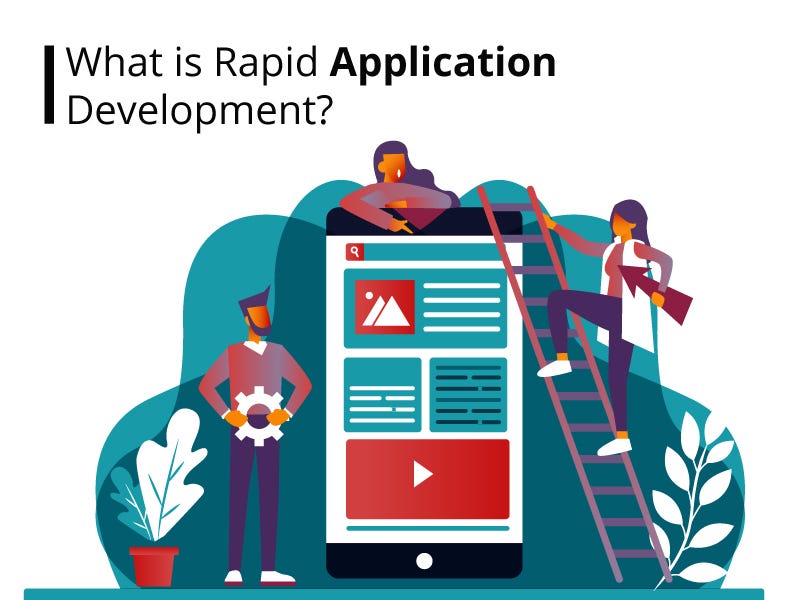What is Rapid Application Development?
RAD — Rapid Application Development, was introduced before the agile process took its place in the software development process. RAD also brought flexibility with it to the entire software development process. However, Rapid Application Development is also a form of the agile software development process. This process was first introduced in 1980. The RAD Invention became a direct end result of the drawbacks of regressive traditional development models which include the Waterfall Software Development Model.

Image Created By Bitrix Infotech Pvt Ltd
RAD is especially well suited for developing software that is driven by user interface requirements. Rapid Application Development facilitates to quickly expand prototypes to test capabilities and features without having to worry too much about their impact on the product. With RAD, you may add or remove functionalities, trade the design of a software program product and clean it up with the aid of eliminating extra stuff, all without harming the product.
In addition, RAD gives the opportunity of low-code rapid application development so that businesses can come up with new applications even faster.
What is the difference between Agile and RAD?
As stated earlier, agile development was introduced much later after RAD. Regardless, it has now more developed and also become popular among the people. Unlike RAD, Agile underlines extra on its models and ideal environment. On the other hand, RAD is a much greater elastic model. It focuses more on the satisfaction of the outcome rather than the strategies and time frame used for delivery. Hence companies who do not have well-installed Agile models normally pick RAD as their ideal improvement model.
The core theme of RAD is totally based on designing short and dirty prototypes, which might be then subtle into production-quality code. The Agile model does not advise developing prototypes, however, it Shows off the systematic development of every incremental characteristic at the end of each journey.
What are the steps involved in RAD?
1. Create a requirements structure
The rapid Application Development version does not want you to begin with a detailed list of specifications. Instead, it encourages builders to ask for requirements at the time. As the task advances deeper into the improvement cycle, the specifics of the requirement can be added to solve the problem. This step sets the stage for the ultimate success of the challenge.

Image Created By Bitrix Infotech Pvt Ltd
This is wherein the developers, customers, stakeholders, and other members take a seat down to discuss the dreams and expectations of the assignment. They also cope with the cutting-edge and ability challenges that can prevent their route during improvement. The key to a successful RAD is for all of the stakeholders and customers to be involved properly from the beginning to define the dreams and expectations.
2. Build User Design
This is the main route of the RAD methodology and what units it uses other than other task control strategies. Once the scope of the challenge is chalked out, it’s time to dive into development. The user design is built through numerous prototype iterations.
During this phase, clients are a part of forces with the builders to make certain that their requirements are being met at each step in the design process. It’s a practically customizable software improvement in which the developer designs a prototype, the user tests it, after which they collaborate on what worked and what didn’t. Ultimately, both the builders and the clients work collectively to ensure that there may be no hole for something to slip through the cracks.
3. Rapid Construction
The prototypes and beta systems developed inside the previous degree are now transformed into working models. Since a massive range of system defects and gaps would be addressed all through the prototyping process, the developers can now flow at complete speed in building the product. It is lovely that even throughout this phase, the quit users provide inputs and support modifications which are ultimately accommodated.
4. Finalize and execute
In this final step, The features, personal experience, and interface of the software program are finalized with the product owner or client. Before handing over or opening the product at the client-side, developers check the software to balance usability and maintainability.
In addition, in this phase of training, the user is also an important task.
The advantages of Rapid Application Development
Since the business methods have changed, every firm wants to sell its product through Applications. Now it has become more mandatory to use RAD as seeing the growing numbers of businesses who want digitalization.

Image Created By Bitrix Infotech Pvt Ltd
Prioritise pace and agility so that IT groups can grow their productivity and improve assignment outcomes. Instead of the everyday turnaround of months or years for brand new perfect applications, speedy application improvement methodology allows IT teams to supply in a be the count of days or weeks.
Let’s see the following benefits of RAD:-
- The capacity to quickly create and share operating prototypes lets in the commercial enterprise review capability earlier within the application existence cycle, supporting to avoid rework that could harm the entire project.
- It Includes extra prototype and capability throughout testing. The venture's existence cycle additionally improves software quality, as requirements can be proven and refined as it is totally based on user feedback.
- It would be better for stakeholders to control risk and can talk and cope with code vulnerabilities even as keeping development techniques going.
- Creating production-prepared apps with quicker methods can advantage the enterprise from its earlier availability, while new capability continues to be released.














Comments